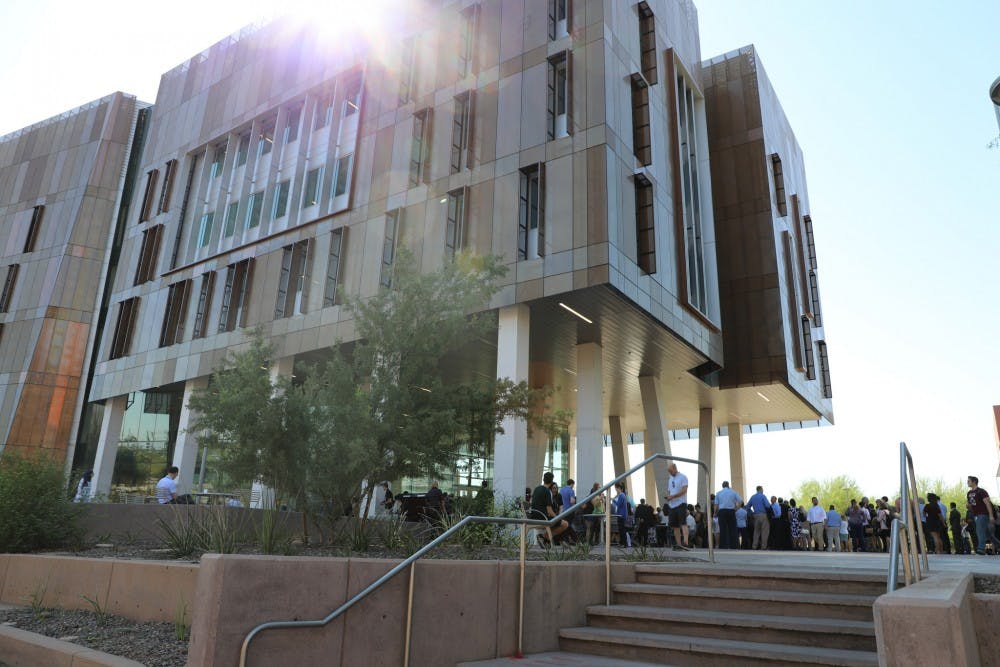Today Biodesign C, a $120 million, five-story complex built to promote cutting-edge research collaboration across a spectrum of scientific subjects, had its grand opening.
With approximately 600 people in attendance, event-goers were able to go on self-guided tours around the 191,035-square-foot facility and examine seven exhibits after a few speeches from ASU leaders including President Michael Crow and Sethuraman Panchanathan, the executive vice president of ASU’s Knowledge Enterprise Development.
The new facility is the culmination of years of planning and construction and another in a string of significant investments the University has made in scientific development and innovation on campus.
Dianne Price, a spokesperson for ASU’s Biodesign Institute, said that Biodesign C was designed to be conducive to openness and collaboration.
“The way that the interior of the building is designed allows us to move people around,” Price said. “Another important feature of the building is that sunlight goes all the way through the building from one side to the next. By having those open spaces, collaboration is more likely than just certainly encouraged."
The building boasts a host of state-of-the-art machinery, including a much-discussed compact X-ray free-electron laser — the world's first.
"That piece of technology has significant implications for how we will produce medicines in the future, how we will produce clean energy and also has implication for the art world,” Price said.
Varun Kelkar, a graduate research assistant at the Biodesign Institute, said the new instruments and machines at Biodesign C will aid researchers in their collaborative efforts.
“We have many departments who do different kinds of research under one roof,” Kelkar said. “A lot of good things are happening because a lot of different departments are coming together and collaborating and doing a good amount of research together.”
Read more: Yes, the new Biodesign C building is going to have a laser
All these new scientific toys means ample security — the room where the laser will be stored has a 4-foot-thick, 36,000 pound lead-shielded door and vibration-proof flooring, with 90 tons of lead bricks to line the vault, among many other precautions.
Valerie Harris, a graduate student who researches Biocomputing, Security and Society at the Biodesign Institute, called Biodesign C a “total collaboration engine.”
“Biodesign is really a cornerstone of the innovation of Arizona State University,” Harris said. “When I was interviewing for graduate school, I remember that somebody told me … ‘If it existed, it's happening at ASU' … There's a lot of people that have crazy ideas and ASU is the place to test those ideas out.”
Biodesign C, which can house up to 80 lead researchers and 400 support staff, will host researchers from outside the Biodesign Institute itself, including from ASU’s School of Molecular Sciences and ASU’s Schools of Engineering.
“It's sort of a non-denominational building in the sense,” Price said.
Crow's speech emphasized that Biodesign provides a forum where scientists and researchers from all disciplines can gather to look to biology as a means of addressing big-picture issues, according to the Biodesign Institute's Twitter.
“I was really attracted to what Michael Crow was saying and all of his relations to Mark Twain and learning about the complexity in earnest about the world,” Harris said. “I think that's what drew me to ASU in the first place. It was learning about the complexity for complexity's sake, not just to learn about it to further someone else's costs, but just learning about it in earnest curiosity.”
Editor's note: Due to a source error, a previous version of the story incorrectly stated the square footage of the building.
Reach the reporter at jlmyer10@asu.edu or follow @jessiemy94 on Twitter.
Like The State Press on Facebook and follow @statepress on Twitter.




